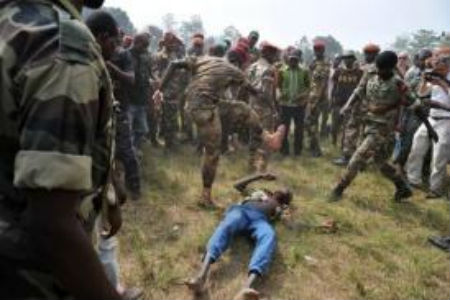
The interim president of Central African Republic told the hundreds of soldiers standing in formation Wednesday that she was proud of them and called on their support to bring order to their anarchic country. Then she left, and the soldiers broke ranks to stab and stomp a man in their midst to death. They dragged his corpse through the streets.
The horrific attack, witnessed by Associated Press journalists, shows the degree of hatred and savagery to which this impoverished country has fallen and the difficulty faced by the international community, which has already deployed thousands of peacekeepers, to try to stabilize it.
Wednesday’s gathering was intended to highlight the rebuilding of the national army, left in tatters when President Francois Bozize was ousted from power in a March 2013 coup. The general in charge of the French military mission in Central African Republic highlighted how the national soldiers “have above all a detailed knowledge of the terrain which will allow us to have them take over the action.”
Interim President Catherine Samba-Panza, who took over last month after the rebel leader who seized power stepped aside amid mounting international pressure, announced that the government soldiers would soon be paid after five months without wages. And she emphasized that the international community would help rearm them.
“I would like to renew my pride in those elements of FACA (Armed Forces of Central African Republic) who are here and to ask them to support my actions wherever they are,” she said. The uniformed soldiers stood at attention in orderly fashion for the speech, some sporting smiles.
But after she left, the soldiers spotted a suspected former member of the Seleka rebellion that had overthrown the government. His name was Idriss, and he was standing among them. They accused him of being an infiltrator, there to spy for Seleka. Out came the first knife.
“I will kill him with my own hands,” shouted one man who had come to enlist in the national army.
The very men expected to protect civilians used knives, bricks and their own feet to attack the man. Troops from the tiny African nation of Burundi surrounded the wounded man to protect him from the growing crowd. He lay wounded on his back and still alive for about five minutes.
But as the crowd moved closer, the peacekeepers withdrew, not even firing warning shots. The attack resumed. Some stabbed him while others kicked him in the face. Still others pelted him with concrete blocks as a crowd cheered.
A police officer jumped out of his truck to try to halt the gruesome attack and was accosted by the crowd and accused of being a traitor. Senior officers managed to extract him from the mob and sped away with him in their pickup.
The crowd dragged Idriss’ corpse through the street, dismembered it and set it ablaze.
Even for a city that sees civilians killed by mobs almost daily, it was a shocking display of violence, underscoring the depth of chaos now gripping Central African Republic.
The 2013 coup ushered in months of turmoil and bitter hatred toward the mostly Muslim rebels and has left anyone accused of collaborating with them vulnerable to attack. The rebels’ 10-month rule was marked by human rights abuses, and sparked a Christian armed movement known as the anti-Balaka, which also has been accused of atrocities.
Tit-for-tat violence killed more than 1,000 people in Bangui alone in a matter of days in December. An untold number have died in the weeks that followed, with most of the attacks in Bangui targeting Muslims.
The violence is unprecedented in a country with little history of inter-communal conflict. There are now 5,000 African peacekeepers and 1,600 French troops on the ground. On Wednesday, they could only stand guard over the charred remains of the victim until Red Cross workers came to remove them.